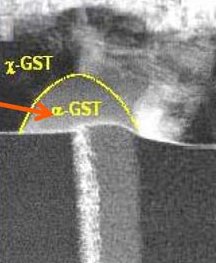
Today Intel and ST MicroElectronics announce another memory breakthrough. The firms say they've doubled the capacity of phase-change memory, a possible replacement for flash memory:
To make their memory cells, Intel and partner ST Microelectronics used a material called GST, a type of glass that has physical states responsive to heat. A tiny heater, controlled by algorithms in the chip, changes the state of the GST by heating a memory cell until it reaches one of four distinct states. (Older systems used the same approach but only worked with two states.) Intel's chief technology officer, Justin Rattner, says the researchers used novel programming algorithms to alter the amount of heat each cell receives, thus controlling its state: "We can do this successfully with a reasonably sized array, and do it at speeds that are commercially viable," he says. The cell is then read by measuring its electrical resistance between two electrodes. The resistance indicates the state of the cell because each state has distinct electrical properties.
By adding two bits per cell, Intel and ST Microelectronics have put phase-change memory on par with today's flash technology, says H.-S. Philip Wong, professor of electrical engineering at Stanford University. Intel has already mastered a similar trick with flash memory in which more than one bit can be stored per memory cell, he says, so this is a logical progression for phase-change memory. "It's rather important to develop this multi-bit storage technology," says Wong. "If you can't do it, then you're disadvantaged by a factor of two."
One of the features that makes phase-change so compelling as a flash alternative is that it has the same benefits as flash with faster speed, says Jim Handy, an analyst at Objective Analysis, a semiconductor market research firm. Like flash, phase-change memory is a non-volatile memory that can store bits even without a power supply. But unlike flash, data can be written to cells much faster, at rates comparable to the dynamic and static random-access memory (DRAM and SRAM) used in all computers and cell phones today. Currently, Handy explains, computer- and cell-phone engineers use DRAM or SRAM combined with flash. DRAM and SRAM are used to read and write data quickly; flash is used to store data when the power is off. "Handset manufacturers are excited about phase-change memory," Handy says, "because it looks like they could get rid of two of the chips [flash and DRAM] and replace them with one phase-change memory chip."